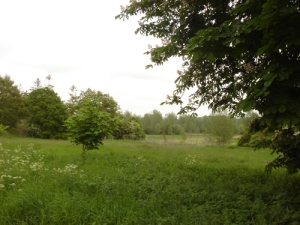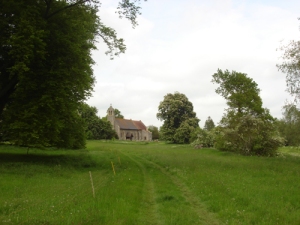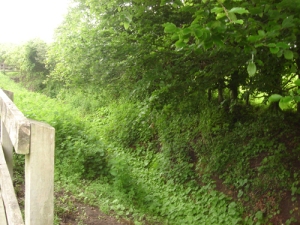I have to confess that I had not heard of the hamlet of Dagworth before I started researching these tales. It wasn’t even a place name on a sign, like Langham. But in the 13th century it appears to have been a place of note – or at least known to Ralph of Coggeshall. He sets the story of the changeling child that we began in Langham in the previous blog there. Dagworth is near Haughley, whose castle, at the time that Ralph’s story takes place, would have been a burnt out ruin from the recent troubles that had beset East Anglia thanks to the ambitions of Hugh Bigod. Ralph sets his tale of supernatural goings on in the reign of King Richard, which means it has to be in the 1190s.
I was wrong to think that Dagworth wasn’t famous though – only last year, in 2012, it was featured on national television, the BBC no less in Michael Wood’s Great British Story, which brought the story of Dagworth’s lost English lord, Breme, who fell at the Battle of Hastings. After that Dagworth’s story was told through Norman lords. Today Dagworth Manor is divided in two, and earlier this year I missed the chance to buy the east half – as you will see from this article in the Daily Mail, it was a little beyond a jobbing writer’s budget! There is a great website on the history of the village for more detail.
What Dagworth was really like in the 12th century is hard to guess, but we do have the Doomsday book data. The manor house must have dominated the village, and we know there was woodland where pigs rootled in the undergrowth. We know there were ploughmen, and meadowland, and that people kept cattle, pigs, sheep and goats. Then as now it was probably marshy, with a stream dividing the settlement. At some point there was a fishpond nearby, and hops and osiers grown – the map names these still. The manor house would have had a chapel – there is no church in the village. Though Chapel Hill on the other side of the railway line is suggestive that there was a chapel there … but the parish church is in Old Newton a couple of miles away.
At that time, Dagworth manor was held by Osbert Fitzhervey. Osbert had connections with the great and the good, and was connected with royalty through his uncle Ranulf de Glanville. Ranulf founded Leiston (originally at miasmic Minsmere) and Butley abbeys, and was related to the Bartholomew de Glanville who figures in another Ralph tale, the Wildman of Orford – a fact which is almost certainly no coincidence. Osbert was born at Dagworth, it seems, around 1160, married Margaret Fitzroscelin of Linstead. He became a royal judge, serving three kings, and died in 1206. His son Richard was born in 1184, which makes him about the right age to experience the ghostly goings on in the early 1190s.
The thing is, Ralph doesn’t like Osbert. It seems possible that he knew him personally as Osbert had ties with land near Coggeshall, at Bradwell only three miles from there. Setting a poltergeist story of a changeling at his house might seem bad enough – but maybe Ralph felt that someone as corrupt as Osbert would attract such uneasy spirits. In his Vision of Thurkill he singles Osbert out for special treatment. Thurkill was a peasant granted a vision of both hell and heaven in 1206 in Stisted, close to both Bradwell and Coggeshall, and he seems to have a vision of Osbert who died that same year – it’s worth quoting in full:
But now Thurkill sees a notable figure, who has to act sins that have been committed in a high station. All England knew the man once, as one of the Chief Justiciaries; most profound in law, most eloquent in speech, but most corrupt in his dealings. He died this very year, suddenly, without a will; and all his ill gotten wealth has been dispersed and squandered. He is placed on a mock tribunal. The Fiends flock around him, pleading a cause, and urging it with statement and counterstatement. He shifts from right to left, listening, noting, taking money from both sides, and fingering and counting the bribes incessantly. But the coins glow in his clutches, and he is forced by the Fiends to cram them down his greedy throat. Then they roll and iron cartwheel up and down his back, pounding him with the massive studs upon it, till he disgorges what he has swallowed. And at a sign the Fiends pick up the coins, and keep for another time.
Ralph certainly has it in for him!
But what about the spirit? Is she a changeling trapped in between this and the Otherworld? Or, is there a hint that she might be a more troubled spirit? Could she be a poltergeist? The text says, ‘He laughed wonderfully … and acted and spoke, also showing himself often through other clandestine acts.’ What were these ‘acts’? The child only shows herself to one person, a maid; otherwise her antics are invisible. The first mentions of poltergeists seem to appear in Roman times, when someone is possessed. Josephus, the Jewish historian speaks of a bowl being turned over by itself as sign that a spirit has been expelled. In the Eyrbyggia Saga from Iceland, a fish is torn apart by unseen hands. Closer to home, St Godric, who was a hermit at Finchale in County Durham (though he was actually from Walpole in Norfolk) in the 10th century who was tormented by a spirit that constantly threw things at him. These visitations are almost always scary and unsettling to these who experience them, but Margaret Fitzroscelin and her household were made of sterner stuff. Ralph goes on: ‘the wife of the knight and the entire household were at first very scared by her talk, but soon her words and ludicrous acts became familiar, she spoke confidently and familiarly to them and was often questioned by them.’ They even left food out for her.
These tales of Ralph and other 12th and 13th century chroniclers often have strange little details that seem to reveal them as truth – such as the chest with the food in it that Malekin takes. But you can also pick up the political mores of the time as well – Malekin is gifted with languages, and can speak Norman-French and Latin – and even ‘English the second language of that region’. Ralph, a Norman himself, is happy to put us English folk in our place, and all his three Suffolk tales deal with the great and the good like Osbert Fitzhervey – even if Ralph didn’t think he was very good at all!



 <
<

